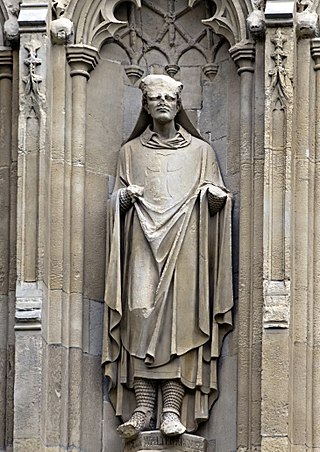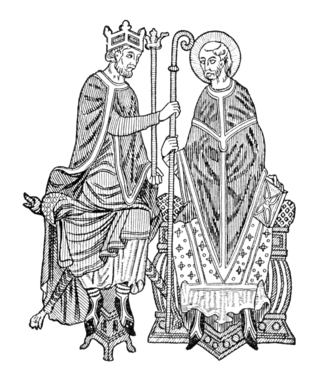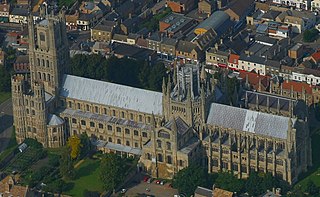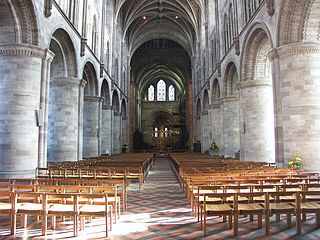Related Research Articles

Otto IV was the Holy Roman Emperor from 1209 until his death in 1218.

Hubert Walter was an influential royal adviser in the late twelfth and early thirteenth centuries in the positions of Chief Justiciar of England, Archbishop of Canterbury, and Lord Chancellor. As chancellor, Walter began the keeping of the Charter Roll, a record of all charters issued by the chancery. Walter was not noted for his holiness in life or learning, but historians have judged him one of the most outstanding government ministers in English history.
William de Corbeil or William of Corbeil was a medieval Archbishop of Canterbury. Very little is known of William's early life or his family, except that he was born at Corbeil, south-east of Paris, and that he had two brothers. Educated as a theologian, he taught briefly before serving the bishops of Durham and London as a clerk and subsequently becoming an Augustinian canon. William was elected to the See of Canterbury as a compromise candidate in 1123, the first canon to become an English archbishop. He succeeded Ralph d'Escures who had employed him as a chaplain.
Ranulf Flambard was a medieval Norman Bishop of Durham and an influential government official of King William Rufus of England. Ranulf was the son of a priest of Bayeux, Normandy, and his nickname Flambard means incendiary or torch-bearer, and may have referred to his personality. He started his career under King William I of England, probably in the compilation of the Domesday Book of 1086, as well as being the keeper of the king's seal. On the death of William I, Ranulf chose to serve the new king of England, William Rufus.

The Investiture Controversy or Investiture Contest was a conflict between the Church and the state in medieval Europe over the ability to choose and install bishops (investiture) and abbots of monasteries and the pope himself. A series of popes in the 11th and 12th centuries undercut the power of the Holy Roman Emperor and other European monarchies, and the controversy led to nearly 50 years of conflict.
Gallicanism is the belief that popular secular authority—often represented by the monarch's or the state's authority—over the Catholic Church is comparable to that of the pope. Gallicanism is a rejection of ultramontanism; it has something in common with Anglicanism, but is nuanced, in that it plays down the authority of the Pope in church without denying that there are some authoritative elements to the office associated with being primus inter pares. Other terms for the same or similar doctrines include Erastianism, Regalism, Febronianism, and Josephinism.
Sir John Maunsell, Provost of Beverley Minster, was a king's clerk and a judge. He served as chancellor to King Henry III and was England's first secretary of state.

Walter de Coutances was a medieval Anglo-Norman bishop of Lincoln and archbishop of Rouen. He began his royal service in the government of Henry II, serving as a vice-chancellor. He also accumulated a number of ecclesiastical offices, becoming successively canon of Rouen Cathedral, treasurer of Rouen, and archdeacon of Oxford. King Henry sent him on a number of diplomatic missions and finally rewarded him with the bishopric of Lincoln in 1183. He did not remain there long, for he was translated to Rouen in late 1184.
A commendatory abbot is an ecclesiastic, or sometimes a layman, who holds an abbey in commendam, drawing its revenues but not exercising any authority over its inner monastic discipline. If a commendatory abbot is an ecclesiastic, however, he may have limited jurisdiction.
Hugh de Puiset was a medieval Bishop of Durham and Chief Justiciar of England under King Richard I. He was the nephew of King Stephen of England and Henry of Blois, who both assisted Hugh's ecclesiastical career. He held the office of treasurer of York for a number of years, which led him into conflict with Henry Murdac, Archbishop of York. In 1153, Hugh was elected bishop of Durham despite the opposition of Murdac.
The Declaration of the Clergy of France was a four-article document of the 1681 assembly of the French clergy. Promulgated in 1682, it codified the principles of Gallicanism into a system for the first time into an official and definitive formula.

Hervey le Breton was a Breton cleric who became Bishop of Bangor in Wales and later Bishop of Ely in England. Appointed to Bangor by King William II of England, when the Normans were advancing into Wales, Hervey was unable to remain in his diocese when the Welsh began to drive the Normans back from their recent conquests. Hervey's behaviour towards the Welsh seems to have contributed to his expulsion from his see. Although the new king, Henry I wished to translate Hervey to the see of Lisieux in Normandy, it was unsuccessful.
Geoffrey of Vendôme was a French Benedictine monk, writer and cardinal. He was born and died at Angers.

Nigel was an Anglo-Norman clergyman and administrator who served as Bishop of Ely from 1133 to 1169. He came from an ecclesiastical family; his uncle Roger of Salisbury was a bishop and government minister for King Henry I, and other relatives also held offices in the English Church and government. Nigel owed his advancement to his uncle, as did Nigel's probable brother Alexander, who like Nigel was advanced to episcopal status. Nigel was educated on the continent before becoming a royal administrator. He served as Treasurer of England under King Henry, before being appointed to the see, or bishopric, of Ely in 1133. His tenure was marked by conflicts with the monks of his cathedral chapter, who believed that Nigel kept income for himself that should properly have gone to them.

François-Étienne Caulet was a French bishop and Jansenist.

Hilary was a medieval bishop of Chichester in England. English by birth, he studied canon law and worked in Rome as a papal clerk. During his time there, he became acquainted with a number of ecclesiastics, including the future Pope Adrian IV, and the writer John of Salisbury. In England, he served as a clerk for Henry of Blois, who was the bishop of Winchester and brother of King Stephen of England. After Hilary's unsuccessful nomination to become Archbishop of York, Pope Eugene III compensated him by promoting him to the bishopric of Chichester in 1147.

Robert de Bethune was a medieval bishop of Hereford. From a knightly family, he became a teacher before becoming a canon by 1115. He was elected prior of Llanthony Priory in the middle 1120s, and was named bishop by King Henry I of England in 1130. As bishop, he was often appointed a judge by the papacy, and was known for the care he took of his diocese.
The assembly of the French clergy was in its origins a representative meeting of the Catholic clergy of France, held every five years, for the purpose of apportioning the financial burdens laid upon the clergy of the French Catholic Church by the kings of France. Meeting from 1560 to 1789, the Assemblies ensured to the clergy an autonomous financial administration, by which they defended themselves against taxation.
The jus naufragii, sometimes lex naufragii, was a medieval custom which allowed the inhabitants or lord of a territory to seize all that washed ashore from the wreck of a ship along its coast. This applied, originally, to all the cargo of the ship, the wreckage itself, and even any passengers who came ashore, who were thus converted into slaves. This latter custom disappeared before the jus naufragii came to the attention of lawmakers.
Ausculta Fili is a papal bull addressed on 5 December 1301, by Pope Boniface VIII to King Philip IV of France.
References
- ↑ also Latin : jus regaliae, jus regale, jus deportus; German : Regalienrecht.
- ↑ Coredon Dictionary of Medieval Terms and Phrases p. 236
- 1 2 Knowles Monastic Order pp. 612–615
- ↑ Poole Domesday Book to Magna Carta p. 170
- ↑ Mason William II p. 139
- ↑ Bartlett England Under the Norman and Angevin Kings p. 175
- ↑ Mason William II pp. 71–72
- ↑ Hollister Henry I pp. 109–110
- ↑ Mortimer Angevin England p. 42
- ↑ Mansi, XXI, 1195.
- ↑ Theodor Joseph Lacomblet, Urkundenbuch für die Geschichte des Niederrheins, I, 288.
- ↑ Mon. Germ.: Const. II, 9.
- ↑ Mon. Germ.: Const. II, 37.
- ↑ Mon. Germ.: Const. II, 58, 60.
- ↑ Mon. Germ.: Const. II, 68.
- ↑ Mon. Germ.: Const. II, 78.
- ↑ Mon. Germ.: Const. II, 285.
- ↑ ep. 224, Patrologia Latina CLXXXII, 392.
- ↑ Mansi, XXIV, 90/